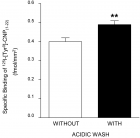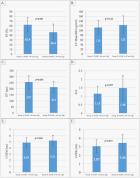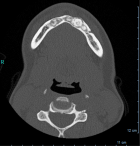Abstract
Mini Review
Lipid-induced cardiovascular diseases
Sumeet Manandhar, Sujin Ju, Dong-Hyun Choi and Heesang Song*
Published: 23 November, 2017 | Volume 2 - Issue 1 | Pages: 085-094
Cardiovascular diseases are the leading cause of death worldwide. There are many evidences that the dysfunctioning lipotoxicity is the one of major factors of cardiovascular diseases such as, atherosclerosis, hypertension, and coronary heart disease. Obesity and diabetes increase circulating lipids that are likely with more generation of toxic intermediates, which leading to the complications associated with cardiovascular diseases. Indeed, lipotoxicity is a metabolic syndrome caused by abnormal lipid accumulation, which leads to cellular dysfunction and necrosis. Here we review the factors that induced pathogenesis of cardiovascular diseases by lipid accumulation and the mechanisms underlying the lipotoxicity.
Read Full Article HTML DOI: 10.29328/journal.jccm.1001018 Cite this Article Read Full Article PDF
Keywords:
Lipotoxicity; Cardiovascular diseases; Pathogenesis
References
- Mattes RD. Fat taste and lipid metabolism in humans. Physiol Behav. 2005; 86: 691-697. Ref: https://goo.gl/nN6YSn
- Schaffer JE. Lipotoxicity: when tissues overeat. Curr Opin Lipidol. 2003; 14: 281-287. Ref: https://goo.gl/ScoErq
- Alshehri AM. Metabolic syndrome and cardiovascular risk. J Family Community Med. 2010; 17: 73-78. Ref: https://goo.gl/d8mLvy
- Chavez JA,Summers SA. Lipid oversupply. selective insulin resistance, and lipotoxicity: molecular mechanisms. Biochim Biophys Acta. 2010; 1801: 252-265. Ref: https://goo.gl/YB4P7f
- Isomaa B, Almgren P, Tuomi T, Forsen B, Lahti K, et al. Cardiovascular morbidity and mortality associated with the metabolic syndrome. Diabetes Care. 2001; 24: 683-689. Ref: https://goo.gl/KRiXB2
- Laaksonen DE, Lakka HM, Niskanen LK, Kaplan GA, Salonen JT, et al. Metabolic syndrome and development of diabetes mellitus: application and validation of recently suggested definitions of the metabolic syndrome in a prospective cohort study. Am J Epidemiol. 2002; 156: 1070-1077. Ref: https://goo.gl/5mcBbN
- Turpin SM, Ryall JG, Southgate R, Darby I, Hevener AL, et al. Examination of 'lipotoxicity' in skeletal muscle of high-fat fed and ob/ob mice. J Physiol. 2009; 587: 1593-1605. Ref: https://goo.gl/npCrgA
- Winzell MS, Svensson H, Enerback S, Ravnskjaer K, Mandrup S, et al. Pancreatic beta-cell lipotoxicity induced by overexpression of hormone-sensitive lipase. Diabetes. 2003; 52: 2057-2065. Ref: https://goo.gl/obLxVH
- Shimabukuro M, Zhou YT, Levi M, Unger RH. Fatty acid-induced beta cell apoptosis: a link between obesity and diabetes. Proc Natl Acad Sci USA. 1998; 95: 2498-2502. Ref: https://goo.gl/djrqfD
- Prentki M, Joly E, El-Assaad W,Roduit R, Malonyl-CoA signaling, lipid partitioning, and glucolipotoxicity: role in beta-cell adaptation and failure in the etiology of diabetes. Diabetes. 2002; 51: 405-413. Ref: https://goo.gl/bnLzvh
- Lupi R, Dotta F, Marselli L, Del Guerra S, Masini M, et al. Prolonged exposure to free fatty acids has cytostatic and pro-apoptotic effects on human pancreatic islets: evidence that beta-cell death is caspase mediated, partially dependent on ceramide pathway, and Bcl-2 regulated. Diabetes. 2002; 51: 1437-1442. Ref: https://goo.gl/BgdR6t
- Robertson RP, Harmon J, Tran PO,Poitout V, Beta-cell glucose toxicity, lipotoxicity, and chronic oxidative stress in type 2 diabetes. Diabetes. 2004; 53: 119-124. Ref: https://goo.gl/Xif2YQ
- Trauner M, Arrese M,Wagner M, Fatty liver and lipotoxicity. Biochim Biophys Acta. 2010; 1801: 299-310. Ref: https://goo.gl/8xD98d
- Ibdah JA, Paul H, Zhao Y, Binford S, Salleng K, et al. Lack of mitochondrial trifunctional protein in mice causes neonatal hypoglycemia and sudden death. J Clin Invest. 2001; 107: 1403-1409. Ref: https://goo.gl/WvQCb8
- Bobulescu IA, Renal lipid metabolism and lipotoxicity. Curr Opin Nephrol Hypertens. 2010; 19: 393-402. Ref: https://goo.gl/CpBSf2
- Kim JA, Montagnani M, Chandrasekran S,Quon MJ. Role of lipotoxicity in endothelial dysfunction. Heart Fail Clin. 2012; 8: 589-607. Ref: https://goo.gl/SbMja6
- Nichols M, Townsend N, Scarborough P, Rayner M. Cardiovascular disease in Europe 2014: epidemiological update. Eur Heart J. 2014; 2950-2959. Ref:
- Abel ED, Litwin SE,Sweeney G, Cardiac remodeling in obesity. Physiol Rev. 2008; 88: 389-419. Ref: https://goo.gl/jh2U9f
- Kenchaiah S, Evans JC, Levy D, Wilson PW, Benjamin EJ, et al. Obesity and the risk of heart failure. N Engl J Med. 2002; 347: 305-313. Ref: https://goo.gl/AazmFW
- Dyntar D, Eppenberger-Eberhardt M, Maedler K, Pruschy M, Eppenberger HM, et al. Glucose and palmitic acid induce degeneration of myofibrils and modulate apoptosis in rat adult cardiomyocytes. Diabetes. 2001; 50: 2105-2113. Ref: https://goo.gl/sJsYL8
- DeFronzo RA, Insulin resistance, lipotoxicity, type 2 diabetes and atherosclerosis: the missing links. The Claude Bernard Lecture 2009. Diabetologia. 2010; 53: 1270-1287. Ref: https://goo.gl/sRDzGc
- Wende AR,Abel ED, Lipotoxicity in the heart. Biochim Biophys Acta. 2010; 1801: 311-319. Ref: https://goo.gl/RZ2tSC
- Goldberg IJ, Trent CM,Schulze PC, Lipid metabolism and toxicity in the heart. Cell Metab. 2012; 15: 805-812. Ref: https://goo.gl/Jb72N7
- Yagyu H, Chen G, Yokoyama M, Hirata K, Augustus A, et al. Lipoprotein lipase (LpL) on the surface of cardiomyocytes increases lipid uptake and produces a cardiomyopathy. J Clin Invest. 2003; 111: 419-426. Ref: https://goo.gl/MFauH3
- Park TS, Hu Y, Noh HL, Drosatos K, Okajima K, et al. Ceramide is a cardiotoxin in lipotoxic cardiomyopathy. J Lipid Res. 2008; 49: 2101-2112. Ref: https://goo.gl/rALwnF
- Halton TL, Willett WC, Liu S, Manson JE, Albert CM, et al. Low-carbohydrate-diet score and the risk of coronary heart disease in women. N Engl J Med. 2006; 355: 1991-2002. Ref: https://goo.gl/NvdZ6S
- Hu FB,Willett WC, Optimal diets for prevention of coronary heart disease. JAMA. 2002; 288: 2569-2578. Ref: https://goo.gl/qgXQY9
- Lavie CJ, Milani RV, Mehra MR,Ventura HO, Omega-3 polyunsaturated fatty acids and cardiovascular diseases. J Am Coll Cardiol. 2009; 54: 585-594. Ref: https://goo.gl/QNpSqw
- Mozaffarian D,Wu JH, Omega-3 fatty acids and cardiovascular disease: effects on risk factors, molecular pathways, and clinical events. J Am Coll Cardiol. 2011; 58: 2047-2067. Ref: https://goo.gl/t66E6q
- Young ME, Guthrie PH, Razeghi P, Leighton B, Abbasi S, et al. Impaired long-chain fatty acid oxidation and contractile dysfunction in the obese Zucker rat heart. Diabetes. 2002; 51: 2587-2595. Ref: https://goo.gl/aj1MRb
- Sharma S, Adrogue JV, Golfman L, Uray I, Lemm J, et al. Intramyocardial lipid accumulation in the failing human heart resembles the lipotoxic rat heart. Faseb j. 2004; 1692-1700. Ref: https://goo.gl/dPWBiw
- Watson KE, Peters Harmel AL,Matson G. Atherosclerosis in type 2 diabetes mellitus: the role of insulin resistance. J Cardiovasc Pharmacol Ther. 2003; 253-260. Ref: https://goo.gl/gPizLV
- Kelley DE. Skeletal muscle fat oxidation: timing and flexibility are everything. J Clin Invest. 2005; 1699-1702. Ref: https://goo.gl/RcohyL
- Terrand J, Bruban V, Zhou L, Gong W, El Asmar Z, et al. LRP1 controls intracellular cholesterol storage and fatty acid synthesis through modulation of Wnt signaling. J Biol Chem. 2009; 381-388. Ref: https://goo.gl/CCydTp
- Alexander RW. Theodore Cooper Memorial Lecture. Hypertension and the pathogenesis of atherosclerosis. Oxidative stress and the mediation of arterial inflammatory response: a new perspective. Hypertension. 1995; 155-161. Ref: https://goo.gl/9Rd8uC
- Hemnes AR, Brittain EL, Trammell AW, Fessel JP, Austin ED, et al. Evidence for right ventricular lipotoxicity in heritable pulmonary arterial hypertension. Am J Respir Crit Care Med. 2014; 325-334. Ref: https://goo.gl/b6Ua5j
- Zhao X. Prevention of local lipotoxicity: a new renoprotective mechanism of peroxisome proliferator-activated receptor-alpha activation in hypertension and obesity? Hypertens Res. 2009; 821-823. Ref: https://goo.gl/T7CDLj
- Kelly DP, Hale DE, Rutledge SL, Ogden ML, Whelan AJ, et al. Molecular basis of inherited medium-chain acyl-CoA dehydrogenase deficiency causing sudden child death. J Inherit Metab Dis. 1992; 171-180. Ref: https://goo.gl/FPmU8b
- Kurtz DM, Rinaldo P, Rhead WJ, Tian L, Millington DS, et al. Targeted disruption of mouse long-chain acyl-CoA dehydrogenase gene reveals crucial roles for fatty acid oxidation. Proc Natl Acad Sci USA. 1998; 15592-15597.Ref: https://goo.gl/DqxeyC
- Drosatos K, Schulze PC. Cardiac lipotoxicity: molecular pathways and therapeutic implications. Curr Heart Fail Rep. 2013; 109-121. Ref: https://goo.gl/qyGyci
- Hickson-Bick DL, Buja LM, McMillin JB. Palmitate-mediated alterations in the fatty acid metabolism of rat neonatal cardiac myocytes. J Mol Cell Cardiol. 2000; 511-519. Ref: https://goo.gl/1se7ws
- Sparagna GC, Hickson-Bick DL, Buja LM, McMillin JB. A metabolic role for mitochondria in palmitate-induced cardiac myocyte apoptosis. Am J Physiol Heart Circ Physiol. 2000; H2124-2132.Ref: https://goo.gl/rUwtzX
- Dbaibo GS, Pushkareva MY, Rachid RA, Alter N, Smyth MJ, et al. p53-dependent ceramide response to genotoxic stress. J Clin Invest.1998; 102: 329-339.Ref: https://goo.gl/mBJUV5
- Rotolo JA, Zhang J, Donepudi M, Lee H, Fuks Z, et al. Caspase-dependent and -independent activation of acid sphingomyelinase signaling. J Biol Chem. 2005; 26425-26434. Ref: https://goo.gl/WaV9Fu
- Dbaibo GS, El-Assaad W, Krikorian A, Liu B, Diab K, et al. Ceramide generation by two distinct pathways in tumor necrosis factor alpha-induced cell death. FEBS Lett. 2001; 7-12. Ref: https://goo.gl/JYXgJj
- Quillet-Mary A, Jaffrezou JP, Mansat V, Bordier C, Naval J, et al. Implication of mitochondrial hydrogen peroxide generation in ceramide-induced apoptosis. J Biol Chem. 1997; 21388-21395.Ref: https://goo.gl/TnhYZ4
- Siskind LJ. Mitochondrial ceramide and the induction of apoptosis. J Bioenerg Biomembr. 2005; 143-153. Ref: https://goo.gl/1RMjof
- Weiss B, Stoffel W. Human and murine serine-palmitoyl-CoA transferase--cloning, expression and characterization of the key enzyme in sphingolipid synthesis. Eur J Biochem. 1997; 239-247.Ref: https://goo.gl/HB7Yc7
- Shimabukuro M, Higa M, Zhou YT, Wang MY, Newgard CB, et al. Lipoapoptosis in beta-cells of obese prediabetic fa/fa rats. Role of serine palmitoyltransferase overexpression. J Biol Chem. 1998; 32487-32490.Ref: https://goo.gl/o9DBkr
- Merrill AH, Jr. De novo sphingolipid biosynthesis: a necessary, but dangerous, pathway. J Biol Chem. 2002; 25843-25846. Ref: https://goo.gl/xy7cMM
- Haimovitz-Friedman A, Kan CC, Ehleiter D, Persaud RS, McLoughlin M, et al. Ionizing radiation acts on cellular membranes to generate ceramide and initiate apoptosis. J Exp Med. 1994; 525-535.Ref: https://goo.gl/ahzCL7
- Hardie DG, Carling D,Carlson M. The AMP-activated/SNF1 protein kinase subfamily: metabolic sensors of the eukaryotic cell? Annu Rev Biochem. 1998; 821-855. Ref: https://goo.gl/tP4hP3
- Chabowski A, Momken I, Coort SL, Calles-Escandon J, Tandon NN, et al. Prolonged AMPK activation increases the expression of fatty acid transporters in cardiac myocytes and perfused hearts. Mol Cell Biochem. 2006; 201-212. Ref: https://goo.gl/E4DPKj
- Habets DD, Coumans WA, Voshol PJ, den Boer MA, Febbraio M, et al. AMPK-mediated increase in myocardial long-chain fatty acid uptake critically depends on sarcolemmal CD36. Biochem Biophys Res Commun. 2007; 204-210.Ref: https://goo.gl/Qo1fFp
- Finck BN, Lehman JJ, Leone TC, Welch MJ, Bennett MJ, et al. The cardiac phenotype induced by PPARalpha overexpression mimics that caused by diabetes mellitus. J Clin Invest. 2002; 121-130.Ref: https://goo.gl/Tgo6Jk
- Vega RB, Huss JM, Kelly DP. The coactivator PGC-1 cooperates with peroxisome proliferator-activated receptor alpha in transcriptional control of nuclear genes encoding mitochondrial fatty acid oxidation enzymes. Mol Cell Biol, 2000; 1868-1876. Ref: https://goo.gl/1XuSzq
- Karbowska J, Kochan Z, Smolenski RT. Peroxisome proliferator-activated receptor alpha is downregulated in the failing human heart. Cell Mol Biol Lett. 2003; 49-53. Ref: https://goo.gl/zfFVAu
- Masamura K, Tanaka N, Yoshida M, Kato M, Kawai Y, et al. Myocardial metabolic regulation through peroxisome proliferator-activated receptor alpha after myocardial infarction. Exp Clin Cardiol. 2003; 61-66. Ref: https://goo.gl/LPRDH7
- Narravula S,Colgan SP. Hypoxia-inducible factor 1-mediated inhibition of peroxisome proliferator-activated receptor alpha expression during hypoxia. J Immunol. 2001; 7543-7548. Ref: https://goo.gl/pvsQDV
- Aoyama T, Peters JM, Iritani N, Nakajima T, Furihata K, et al. Altered constitutive expression of fatty acid-metabolizing enzymes in mice lacking the peroxisome proliferator-activated receptor alpha (PPARalpha). J Biol Chem. 1998; 5678-5684. Ref: https://goo.gl/6N7BKG
- Lee SS, Pineau T, Drago J, Lee EJ, Owens JW, et al. Targeted disruption of the alpha isoform of the peroxisome proliferator-activated receptor gene in mice results in abolishment of the pleiotropic effects of peroxisome proliferators. Mol Cell Biol. 1995; 3012-3022. Ref: https://goo.gl/EVfL3d
- Kersten S. Peroxisome proliferator activated receptors and lipoprotein metabolism. PPAR Res. 2008; 132960. Ref: https://goo.gl/vmxnLo
- Yoon M. PPARalpha in Obesity: Sex Difference and Estrogen Involvement. PPAR Res. 2010. Ref: https://goo.gl/dFMJ2x
- Inoguchi T, Battan R, Handler E, Sportsman JR, Heath W, et al. Preferential elevation of protein kinase C isoform beta II and diacylglycerol levels in the aorta and heart of diabetic rats: differential reversibility to glycemic control by islet cell transplantation. Proc Natl Acad Sci U S A. 1992; 11059-11063. Ref: https://goo.gl/49QxVc
- Jalili T, Manning J,Kim S. Increased translocation of cardiac protein kinase C beta2 accompanies mild cardiac hypertrophy in rats fed saturated fat. J Nutr. 2003; 358-361. Ref: https://goo.gl/E9WeXu
- Fujino T, Asaba H, Kang MJ, Ikeda Y, Sone H, et al. Low-density lipoprotein receptor-related protein 5 (LRP5) is essential for normal cholesterol metabolism and glucose-induced insulin secretion. Proc Natl Acad Sci U S A. 2003; 229-234. Ref: https://goo.gl/TzbGv6
- Kim DH, Cho YM, Lee KH, Jeong SW,Kwon OJ. Oleate protects macrophages from palmitate-induced apoptosis through the downregulation of CD36 expression. Biochem Biophys Res Commun. 2017; 477-482. Ref: https://goo.gl/ftVFm9
- Wen SY, Velmurugan BK, Day CH, Shen CY, Chun LC, et al. High density lipoprotein (HDL) reverses palmitic acid induced energy metabolism imbalance by switching CD36 and GLUT4 signaling pathways in cardiomyocyte. J Cell Physiol. 2017; 3020-3029. Ref: https://goo.gl/oph6mt
- Park SY, Cho YR, Kim HJ, Higashimori T, Danton C, et al. Unraveling the temporal pattern of diet-induced insulin resistance in individual organs and cardiac dysfunction in C57BL/6 mice. Diabetes. 2005; 3530-3540. Ref: https://goo.gl/LtGceU
- Iozzo P, Chareonthaitawee P, Dutka D, Betteridge DJ, Ferrannini E, et al. Independent association of type 2 diabetes and coronary artery disease with myocardial insulin resistance. Diabetes. 2002; 3020-3024. Ref: https://goo.gl/nEBTVo
- Mazumder PK, O'Neill BT, Roberts MW, Buchanan J, Yun UJ, et al. Impaired cardiac efficiency and increased fatty acid oxidation in insulin-resistant ob/ob mouse hearts. Diabetes. 2004; 2366-2374. Ref: https://goo.gl/oeS4W2
- How OJ, Aasum E, Severson DL, Chan WY, Essop MF, et al. Increased myocardial oxygen consumption reduces cardiac efficiency in diabetic mice. Diabetes. 2006; 466-473. Ref: https://goo.gl/2mXJ4A
- Belke DD, Larsen TS, Gibbs EM, Severson DL. Altered metabolism causes cardiac dysfunction in perfused hearts from diabetic (db/db) mice. Am J Physiol Endocrinol Metab. 2000; 1104-1113. Ref: https://goo.gl/DkGsHp
- Kolter T, Uphues I,Eckel J. Molecular analysis of insulin resistance in isolated ventricular cardiomyocytes of obese Zucker rats. Am J Physiol. 1997; 59-67. Ref: https://goo.gl/GcveR7
- Ozcan U, Cao Q, Yilmaz E, Lee AH, Iwakoshi NN, et al. Endoplasmic reticulum stress links obesity, insulin action, and type 2 diabetes. Science, 2004; 457-461. Ref: https://goo.gl/bRDo8T
- Wu W, Muchir A, Shan J, Bonne G,Worman HJ. Mitogen-activated protein kinase inhibitors improve heart function and prevent fibrosis in cardiomyopathy caused by mutation in lamin A/C gene. Circulation. 2011; 53-61. Ref: https://goo.gl/Qa4PS9
- Turdi S, Kandadi MR, Zhao J, Huff AF, Du M, et al. Deficiency in AMP-activated protein kinase exaggerates high fat diet-induced cardiac hypertrophy and contractile dysfunction. J Mol Cell Cardiol. 2011; 712-722. Ref: https://goo.gl/ijV3gp
- Li YJ, Wang PH, Chen C, Zou MH,Wang DW. Improvement of mechanical heart function by trimetazidine in db/db mice. Acta Pharmacol Sin. 2010; 560-569. Ref: https://goo.gl/RV6C6P
- Tan SH, Shui G, Zhou J, Li JJ, Bay BH, et al. Induction of autophagy by palmitic acid via protein kinase C-mediated signaling pathway independent of mTOR (mammalian target of rapamycin). J Biol Chem. 2012; 14364-14376. Ref: https://goo.gl/MBkRby
- Marsh SA, Powell PC, Dell'italia LJ,Chatham JC. Cardiac O-GlcNAcylation blunts autophagic signaling in the diabetic heart. Life Sci. 2013; 648-656. Ref: https://goo.gl/JkXCdK
- Khan MJ, Rizwan Alam M, Waldeck-Weiermair M, Karsten F, Groschner L, et al. Inhibition of autophagy rescues palmitic acid-induced necroptosis of endothelial cells. J Biol Chem. 2012; 21110-21120. Ref: https://goo.gl/jBfij3
- Zhang QJ, Holland WL, Wilson L, Tanner JM, Kearns D, et al. Ceramide mediates vascular dysfunction in diet-induced obesity by PP2A-mediated dephosphorylation of the eNOS-Akt complex. Diabetes. 2012; 1848-1859. Ref: https://goo.gl/2K6CYx
- Ussher JR, Folmes CD, Keung W, Fillmore N, Jaswal JS, et al. Inhibition of serine palmitoyl transferase I reduces cardiac ceramide levels and increases glycolysis rates following diet-induced insulin resistance. PLoS One. 2012; e37703. Ref: https://goo.gl/HeE3o4
- Rame JE, Barouch LA, Sack MN, Lynn EG, Abu-Asab M, et al. Caloric restriction in leptin deficiency does not correct myocardial steatosis: failure to normalize PPAR{alpha}/PGC1{alpha} and thermogenic glycerolipid/fatty acid cycling. Physiol Genomics. 2011; 726-738. Ref: https://goo.gl/c9ZM47
- Gordon GB. Saturated free fatty acid toxicity. II. Lipid accumulation, ultrastructural alterations, and toxicity in mammalian cells in culture. Exp Mol Pathol. 1977; 262-276. Ref: https://goo.gl/dj9TM7
- Greenberg AS, Coleman RA, Kraemer FB, McManaman JL, Obin MS, et al. The role of lipid droplets in metabolic disease in rodents and humans. J Clin Invest. 2011; 2102-2110. Ref: https://goo.gl/res3cF
- Wang H, Sreenivasan U, Hu H, Saladino A, Polster BM, et al. Perilipin 5, a lipid droplet-associated protein, provides physical and metabolic linkage to mitochondria. J Lipid Res. 2011; 2159-2168. Ref: https://goo.gl/ZfCy7H
- Kuramoto K, Okamura T, Yamaguchi T, Nakamura TY, Wakabayashi S, et al. Perilipin 5, a lipid droplet-binding protein, protects heart from oxidative burden by sequestering fatty acid from excessive oxidation. J Biol Chem. 2012; 23852-23863. Ref: https://goo.gl/6QDxYr
- Jordan SD, Kruger M, Willmes DM, Redemann N, Wunderlich FT, et al. Obesity-induced overexpression of miRNA-143 inhibits insulin-stimulated AKT activation and impairs glucose metabolism. Nat Cell Biol. 2011; 434-446. Ref: https://goo.gl/W5wpR7
- Jheng HF, Tsai PJ, Guo SM, Kuo LH, Chang CS, et al. Mitochondrial fission contributes to mitochondrial dysfunction and insulin resistance in skeletal muscle. Mol Cell Biol. 2012; 309-319. Ref: https://goo.gl/LyUoeT
Similar Articles
-
Investigation of Retinal Microvascular Findings in patients with Coronary Artery DiseaseTolga Doğan*,Osman Akın Serdar,Naile Bolca Topal,Özgür Yalçınbayır. Investigation of Retinal Microvascular Findings in patients with Coronary Artery Disease. . 2017 doi: 10.29328/journal.jccm.1001012; 2: 042-049
-
Lipid-induced cardiovascular diseasesSumeet Manandhar,Sujin Ju,Dong-Hyun Choi,Heesang Song*. Lipid-induced cardiovascular diseases. . 2017 doi: 10.29328/journal.jccm.1001018; 2: 085-094
-
The complex interplay in the regulation of cardiac pathophysiologic functionalities by protein kinases and phosphatasesChrysanthus Chukwuma Sr*. The complex interplay in the regulation of cardiac pathophysiologic functionalities by protein kinases and phosphatases. . 2021 doi: 10.29328/journal.jccm.1001118; 6: 048-054
-
Correlation between chronic inflammation of rheumatoid arthritis and coronary lesions: “About a monocentric series of 202 cases”Nassime Zaoui*,Amina Boukabous,Nabil Irid,Nadhir Bachir,Ali Terki. Correlation between chronic inflammation of rheumatoid arthritis and coronary lesions: “About a monocentric series of 202 cases”. . 2022 doi: 10.29328/journal.jccm.1001144; 7: 109-114
-
Faecal Transplant Therapy: A Promising Treatment Modality for Cardiovascular DiseasesK Pushkala, Purshottam D Gupta*. Faecal Transplant Therapy: A Promising Treatment Modality for Cardiovascular Diseases. . 2023 doi: 10.29328/journal.jccm.1001162; 8: 108-113
-
Association of Periprocedural Haemoglobin Reduction and Myocardial Injury in Patients with Unstable Angina Undergoing Percutaneous Coronary InterventionSushil Kumar Bagchi*, Md Moniruzzaman, Sharifun Nahar, Md Khalequzzaman, Sanjib Chowdhury, Amal Kumar Choudhury. Association of Periprocedural Haemoglobin Reduction and Myocardial Injury in Patients with Unstable Angina Undergoing Percutaneous Coronary Intervention. . 2023 doi: 10.29328/journal.jccm.1001166; 8: 137-141
-
Unmasking the Viral Veil: Exploring the Cardiovascular Intrigue of Pathogenic InfectionsZahra Zahid Piracha, Syed Shayan Gilani, Muhammad Nouman Tariq, Umar Saeed, Azka Sohail, Umer Ali Abbasi, Abrisham Akbariansaravi, Muhammad Shahmeer Fida Rana, Ayesha Basra, Faizan Faisal, Madeeha Rasool, Misbah Ghazal, Mubeen Ur Rehman, Hussain Ghya. Unmasking the Viral Veil: Exploring the Cardiovascular Intrigue of Pathogenic Infections. . 2023 doi: 10.29328/journal.jccm.1001168; 8: 152-157
-
Poor Diet Leading to the Increasing Risk of Atherosclerosis in the WorldBijaya Bhusal*. Poor Diet Leading to the Increasing Risk of Atherosclerosis in the World. . 2024 doi: 10.29328/journal.jccm.1001195; 9: 142-147
Recently Viewed
-
Exophthalmos Revealing a Spheno Temporo Orbital MeningiomaHassina S*, Krichene MA, Hazil Z, Bekkar B, Hasnaoui I, Robbana L, Bardi S, Akkanour Y, Serghini L, Abdallah EL. Exophthalmos Revealing a Spheno Temporo Orbital Meningioma. Int J Clin Exp Ophthalmol. 2024: doi: 10.29328/journal.ijceo.1001055; 8: 001-003
-
Value of electrocardiographic T wave inversion in lead aVL in prediction of Mid Left Anterior Descending Stenosis in patients with stable Coronary Artery diseaseGehan Magdy*,Awad Yousef. Value of electrocardiographic T wave inversion in lead aVL in prediction of Mid Left Anterior Descending Stenosis in patients with stable Coronary Artery disease. J Cardiol Cardiovasc Med. 2017: doi: 10.29328/journal.jccm.1001015; 2: 056-062
-
Calciphylaxis in HemodialysisLuca Sgarabotto*, Paola Baldini Anastasio, Nicola Marchionna, Monica Zanella. Calciphylaxis in Hemodialysis. J Clini Nephrol. 2023: doi: 10.29328/journal.jcn.1001107; 7: 044-046
-
Metabolic syndrome: A case reportDragan Klaric,Marta Martinis*,Marta Klaric. Metabolic syndrome: A case report. Ann Clin Endocrinol Metabol. 2021: doi: 10.29328/journal.acem.1001022; 5: 031-035
-
Utilization of Molecular Simulation Applications for Stability Testing of Anthocyanin Compounds in Black ElderberryRichard Benedict*. Utilization of Molecular Simulation Applications for Stability Testing of Anthocyanin Compounds in Black Elderberry. Arch Biotechnol Biomed. 2023: doi: 10.29328/journal.abb.1001035; 7: 012-017
Most Viewed
-
Evaluation of Biostimulants Based on Recovered Protein Hydrolysates from Animal By-products as Plant Growth EnhancersH Pérez-Aguilar*, M Lacruz-Asaro, F Arán-Ais. Evaluation of Biostimulants Based on Recovered Protein Hydrolysates from Animal By-products as Plant Growth Enhancers. J Plant Sci Phytopathol. 2023 doi: 10.29328/journal.jpsp.1001104; 7: 042-047
-
Sinonasal Myxoma Extending into the Orbit in a 4-Year Old: A Case PresentationJulian A Purrinos*, Ramzi Younis. Sinonasal Myxoma Extending into the Orbit in a 4-Year Old: A Case Presentation. Arch Case Rep. 2024 doi: 10.29328/journal.acr.1001099; 8: 075-077
-
Feasibility study of magnetic sensing for detecting single-neuron action potentialsDenis Tonini,Kai Wu,Renata Saha,Jian-Ping Wang*. Feasibility study of magnetic sensing for detecting single-neuron action potentials. Ann Biomed Sci Eng. 2022 doi: 10.29328/journal.abse.1001018; 6: 019-029
-
Pediatric Dysgerminoma: Unveiling a Rare Ovarian TumorFaten Limaiem*, Khalil Saffar, Ahmed Halouani. Pediatric Dysgerminoma: Unveiling a Rare Ovarian Tumor. Arch Case Rep. 2024 doi: 10.29328/journal.acr.1001087; 8: 010-013
-
Physical activity can change the physiological and psychological circumstances during COVID-19 pandemic: A narrative reviewKhashayar Maroufi*. Physical activity can change the physiological and psychological circumstances during COVID-19 pandemic: A narrative review. J Sports Med Ther. 2021 doi: 10.29328/journal.jsmt.1001051; 6: 001-007

HSPI: We're glad you're here. Please click "create a new Query" if you are a new visitor to our website and need further information from us.
If you are already a member of our network and need to keep track of any developments regarding a question you have already submitted, click "take me to my Query."
























































































































































